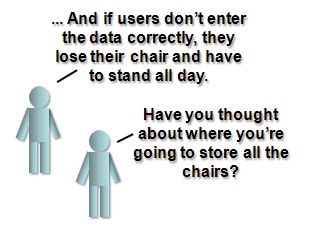« The hitchhikers guide to Data Quality | Good Data is a force for good. »
Data quality challenges: behavioral inertia and its evil opposite
Often, I hear someone say something like “this would be much easier if users would just…” or “If only we could convince the sales people that…”. Technology folks often are frustrated by the people component of the complex systems they are trying to install.
People are not a problem solved by technology
Some try to ignore the issue, or solve it with technology alone- “If we write complex enough validation into the data entry form people HAVE to enter good data” or “Our matching algorithms will resolve the issues in real time.”
 Others try to use sophisticated training, documentation, bonus plans or punishment plans to get the behavior they want.
Others try to use sophisticated training, documentation, bonus plans or punishment plans to get the behavior they want.
Obviously, components of both approaches are going to be used to some extent- but don’t lose sight of the fact that people ARE the process- and the heart of your business. It’s the sales guys that drive revenue, and its the sales order people, or help desk operators, or engineers in your manufacturing facilities that you are building the new system for that are creating all the value. You are a person too- think about their motivations, and how to take advantage of their abilities and enthusiasm- not how to remove them from the equation.
I often think that there are two powerful forces at work in the minds of all of us- oddly, they are opposites, and yet can co-exist even in the same person at the same moment. Some people are strongly to one side or the other.
Behavioral Inertia: Change is bad
We’ve all see this resistance to change, and in many cases people have this tendency for good reasons (that last disastrous ERP implementation where the new processes were not properly checked, and everyone worked 15 hour days for weeks while customers were screaming into their phones about how screwed up everything was, for example.)
Remember, resistance to bad change that is going to screw everything up is a good thing.
In other cases, however, it is unfounded, and it is a real problem- things have to change to move forward. Sometimes risks have to be taken, and there will be bumpy periods before a much better steady state is achieved.
People have a natural resistance to this because change is the unknown.
Hyper Active change syndrome: We can’t wait to do it right- we have to act NOW
This is the evil opposite twin of behavioral inertia. (It’s like that episode when Captain Kirk got split in a transporter incident- you know.)
You can identify people with this force at work by phrases like “We’re a dynamic organisation, we’re being proactive not reactive, our processes are fluid- its the way it is with business in the fast lane” or my personal favorite- “We don’t have time to get the data, we’ll have to go with our gut.”
Hyperactive changers will often try to get their way by always creating a sense of urgency: “The technology isn’t moving fast enough for us, we can’t wait for those changes to be approved, all the process is slowing us down, our customers are demanding speed”
Hyperactive changers are dangerous because they often ignore or circumvent processes in the name of expediency, generating risk and forcing others to waste effort compensating, and generally causing chaos. They want to change things so often, that efficiencies of new processes are never realized- everyone is on a constant learning curve and never gets in the groove.
Balance the forces, find your high-speed tortoise
Think of the story of the Tortoise and the Hare. The Hare, with all its speed, could not figure out that the process was start, run, finish, and completely wasted his speed advantage by having a nap.
On the other hand, while the Tortoise’s complete dedication to his goal and process is admirable, you can’t count on the incompetence of your competition. (And now that all Hares are no doubt told this story throughout their childhood, its unlikely many tortoise get away with the same trick.)
They key lies in between- we need to work with our organization to foster an environment where we value process, and consistency, but understand that a steady, relentless change to optimize is needed, and valuable. When one or the other of our behavioral urges overcomes us, we’ll find that people are the problem in our initiatives. If we balance them, and communicate with everybody, we can find ways to make things work, even without perfect cooperation at all times from everyone.
Not too slow, not too fast, always value process without letting it be your slave master. And for goodness sake, forget about going with your gut- go out and get some DATA!
« The hitchhikers guide to Data Quality | Good Data is a force for good. »



